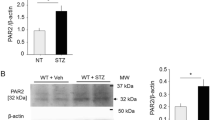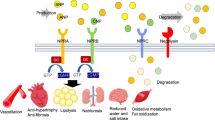Abstract
Nitric oxide (NO) is the principal vasoactive substance produced by the vascular endothelium with antitrombotic, antiatherogenic and vasodilator actions. The loss of these functions is now known as endothelial dysfunction (ED) and it has been proposed that it is the final common pathway in cardiovascular disease. At the moment there is an important body of evidence that supports the proposal that ED is a consequence of an imbalance between the free radicals, NO, superoxide (O−2) and peroxynitrate (ONOO−). This imbalance is the result of the actions of well known risk factors associated with an inappropriate diet and infection-inflammation. Angiotensin-converting enzyme (ACE) inhibitors are highly effective against a variety of cardiovascular disorders. Experimental and clinical studies have demonstrated a beneficial effect of ACE inhibition on endothelial function. This action is mainly due to an increase in the concentration of bradykinin, which stimulates NO production. ACE inhibitors also block the formation of angiotensin II that results in a lower production of O−2. These effects lead to improve the imbalance between NO and O−2 observed in cardiovascular disease. This proposal is supported by different clinical trials that have shown that the ACE inhibitors with higher affinity by the tissular ACE, such as quinapril, are the most effective in reversing ED principally by accumulating bradykinin. Recently, the HOPE study conducted in patients at a high risk of cardiovascular events, showed how ramipril, an ACE inhibitor with high affinity by tissular ACE, decreased the mortality rate due to cardiovascular disease independently of changes in blood pressure.
This is a preview of subscription content, access via your institution
Access options
Subscribe to this journal
Receive 12 digital issues and online access to articles
$119.00 per year
only $9.92 per issue
Buy this article
- Purchase on Springer Link
- Instant access to full article PDF
Prices may be subject to local taxes which are calculated during checkout

Similar content being viewed by others
References
Moncada S et al. The L-arginine: nitric oxide pathway J Cardiovasc Pharmacol 1991 17: S1–S9
Moncada S, Vane JR . Unstable metabolites of arachidonic acid and their role in haemostasis and thrombosis Br Med Bull 1978 34: 129–135
Ronson R, Nakamura M, Vinten-Johansen J . The cardiovascular effects and implications of peroxynitrite Cardiovasc Res 1999 44: 47–59
Clarkson P et al. Impaired vascular reactivity in insulin-dependent diabetes mellitus is related to disease duration and low density lipoprotein cholesterollevels J Am Coll Cardiol 1996 28: 573–579
Panza JA, Quyyumi AA, Brush JE Jr, Epstein SE . Abnormal endothelium-dependent vascular relaxation inpatients with essential hypertension N Engl J Med 1990 323: 22–27
McVeigh GE, Lemay L, Morgan D, Cohn JN . Effects of long-term cigarette smoking on endothelium-dependent responses in humans Am J Cardiol 1996 78: 668–672
Accini JL et al. Colombian study to assess the use of noninvasive determination of endothelium-mediated vasodilation (CANDEV). Normal values and factors associated Endothelium 2000 8: 157–166
Moncada S, Higgs A . The L-arginine-nitric oxide Pathway N Engl J Med 1993 329: 2002–2012
Hingorani A et al. A common variant of the endothelial nitric oxide synthase gene is a risk factor for coronary atherosclerosis in the east anglian region of the UK Circulation 1999 100: 1515–1520
Leiper J, Vallance P . Biological significance of endogenous methilarginines that inhibit nitric oxide synthases Cardiovasc Res 1999 43: 542–548
Beckman JS et al. Apparent hydrooxyl radical production by peroxynitrite: implications of endothelial injury from nitric and superoxide Proc Natl Acad Sci 1990 87: 1620–1624
Lopez-Jaramillo P et al. An integrated proposal to explain the epidemic of cardiovascular disease in a developing country: from socioeconomic factors to free radicals Cardiology 2001 96: 1–6
Drewnowski A, Popkin BM . The nutrition transition: new trends in the global diet Nutr Rev 1997 55: 31–43
Ohara Y, Peterson TE, Harrison DG . Hypercholesterolemia increases endothelial superoxide anion production J Clin Invest 1993 91: 2546–2551
Nguyen-Khoa T et al. Oxidized low-density lipoprotein induces macrophage respiratory burst via its protein moiety: a novel pathway in atherogenesis? Biochem Biophys Res Commun 1999 262: 804–809
Vallance P, Collier J, Bhagat K . Infection, inflammation and infarction: does acute endothelial dysfunction provide a link? Lancet 1997 349: 1391–1392
Volk T, Hensel M, Schuster H, Kox WJ . Secretion of MCP-1 and IL-6 by citokine stimulated production of reactive oxygen species in endothelial cells Mol Cell Biochem 2000 206: 105–112
Hingorani A et al. Acute systemic inflammation impairs endothelium-dependent dilatation in humans Circulation 2000 102: 994–999
Fichtlscherer S et al. Elevated C-reactive protein levels and impaired endothelial vasoreactivity inpatients with coronary artery disease Circulation 2000 102: 1000–1006
Bautista L et al. Is C-reactive protein an independent risk factor for essential hypertension? J Hypertens 2001 19: 857–861
Pfeiffer MA . ACE inhibition in acute myocardial infarction N Engl J Med 1995 332: 118–120
Vanhoutte P et al. Endothelium-dependent effects of converting-enzyme inhibitors J Cardiovasc Pharmacol 1993 22: S10–S16
Mancini J et al. Angiotensin-converting enzyme inhibition with quinapril improves endothelial vasomotor dysfunction inpatients with coronary artery disease. The TREND (Trial on Reversing Endothelial Dysfunction) Study Circulation 1996 94: 258–265
Lyons D, Webster J, Benjamin N . Effect of enalapril and quinapril on forearm vascular ACE in man Eur J Clin Pharmacol 1997 51: 373–378
Johnson CI et al. Comparative studies of tissue inhibition by angiotensin converting enzyme inhibitors J Hypertens 1989 7: S11–S16
Anderson TJ et al. Comparative study of ACE-inhibition, angiotensin II antagonism, and calciumchannel blockade on flow-mediated vasodilation inpatients with coronary disease (BANFF Study) J Am Coll Cardiol 2000 35: 60–66
Linz W et al. Interactions among ACE, kinins and NO Cardiovasc Res 1999 43: 549–561
Mombuili J-V, Vanhoutte PM . Kinins and endothelial control of vascular smooth muscle Annu Rev Pharmacol Toxicol 1996 35: 679–705
Horning B, Kohler C, Drexler H . Role of bradykinin in mediating vascular effects of angiotensin-converting enzyme inhibitors in humans Circulation 1997 95: 1115–1118
Ferreira SH et al. Activity of various fractions of bradykinin potentiating factor against angiotensin I converting enzyme Nature 1970 225: 379–380
Rajagoplan S et al. Angiotensin II-mediated hypertension in the rat increases vascular superoxide production via membrane NADH/NADPH oxidase activation. Contribution to alterations of vasomotor tone J Clin Invest 1996 97: 1916–1923
Münzel T et al. Hydralazine prevents nitroglycerin tolerance by inhibiting activation of a membrane-bound NADH oxidase J Clin Invest 1996 98: 1465–1470
López-Jaramillo P et al. Cyclic guanosine 3′, 5′ monophosphate concentrations in preeclampsia: effects of hydralazine Br J Obst Gynecol 1996 103: 33–38
López-Jaramillo P . Calcium, nitric oxide and preeclampsia Seminars Perinatol 2000 24: 33–36
The Heart Outcomes Prevention Evaluation Study (HOPE) investigators. Effects of an Angiotensin Converting enzyme inhibitor, Ramipril, on cardiovascular events in high riskpatients N Engl J Med 2000 342: 145–153
Author information
Authors and Affiliations
Corresponding author
Rights and permissions
About this article
Cite this article
López-Jaramillo, P., Casas, J. Blockade of endothelial enzymes: new therapeutic targets. J Hum Hypertens 16 (Suppl 1), S100–S103 (2002). https://doi.org/10.1038/sj.jhh.1001353
Published:
Issue Date:
DOI: https://doi.org/10.1038/sj.jhh.1001353
Keywords
This article is cited by
-
Anti-inflammatory Actions of Quinapril
Cardiovascular Drugs and Therapy (2007)
-
A randomized, double blind, cross-over, placebo-controlled clinical trial to assess the effects of Candesartan on the insulin sensitivity on non diabetic, non hypertense subjects with dysglyce mia and abdominal obesity. "ARAMIA"
Trials (2006)



